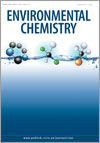
Environmental Chemistry
Volume 9 Number 2 2012
EN10074 Possible contribution of triboelectricity to snow–air interactions
Environmental context. Polar near-surface snow can act as a chemical reactor that alters the composition and chemistry of snow and the overlying air. Although the mechanisms and driving forces of these reactions have long been debated, triboelectrification (production of electrostatic charges by friction) of snow by wind has not yet been considered as a factor. It is proposed that in polar regions, triboelectrification could significantly influence the composition and chemistry of snow.
EN10074 Abstract | EN10074 Full Text | EN10074PDF (118 KB) Open Access Article
EN11151 Comments on 'Possible contribution of triboelectricity to snow–air interactions'
EN11151 Full Text | EN11151PDF (531 KB) Open Access Article
EN11147 Comment on ‘Possible contribution of triboelectricity to snow–air interactions'
EN11147 Full Text | EN11147PDF (79 KB) Open Access Article
EN11072Modelling of arsenate retention from aqueous solutions by living coryneform double-mutant bacteria
Environmental context. Industrial development has favoured the release of toxic elements to the environment and monitoring and assessment their environmental impact are key points. An important aspect of understanding these concerns is to evaluate how toxic substances interact with microorganisms, which has critical implications in the environment. Current studies show that heavy metals have the potential to affect bacterial viability, although a great deal remains to be understood concerning metal speciation using engineered bacterial cells.
EN11134Arsenic speciation in food chains from mid-Atlantic hydrothermal vents
Environmental context. Arsenic occurs in marine organisms at high levels and in many chemical forms. A common explanation of this phenomenon is that algae play the central role in accumulating arsenic by producing arsenic-containing sugars that are then converted into simpler organic arsenic compounds found in fish and other marine animals. We show that animals in deep-sea vent ecosystems, which are uninhabited by algae, contain the same organic arsenic compounds as do pelagic animals, indicating that algae are not the only source of these compounds.
EN11076Occurrence of widely used organic UV filters in lake and river sediments
Environmental context. Personal care products containing organic chemicals to filter the sun’s UV rays are produced and used on a broad scale worldwide. Consequently, these organic UV filters are now widespread in the environment. We investigate the occurrence of seven common organic UV filters in river and lake sediments thereby providing valuable data for the future environmental risk assessment of these chemicals to the benthic community of freshwater ecosystems.
EN11119Adsorption of perfluorooctanoic acid and perfluorooctanesulfonic acid to iron oxide surfaces as studied by flow-through ATR-FTIR spectroscopy
Environmental context. Perfluoroalkyl compounds are organic contaminants that exhibit strong resistance to chemical- and microbial-degradation. As partitioning between solid and aqueous phases is expected to control the transport of perfluoroalkyl compounds, we studied the molecular mechanisms of their adsorption–desorption at a representative Fe oxide surface using in situ molecular spectroscopy. The results provide valuable information on the types of bonds formed, and enable a better understanding of the transport and fate of these organic contaminants in natural environments.
EN11143Is there any isotopic fractionation of nitrate associated with diffusion and advection?
Environmental context. Anthropogenic nitrogen inputs have significant effects on terrestrial and aquatic ecosystems, the extent of which can be traced by using the natural stable isotopic composition of nitrate to integrate the sources of nitrogen and the biological processes of their production. In ecosystems, nitrates are transported by diffusion in water and advection of water masses, but these physical processes have not been characterised in terms of isotopic fractionation. We report experiments demonstrating that physical transport processes have a negligible effect on the isotopic composition of dissolved nitrate.
EN11143 Abstract | EN11143 Full Text | EN11143PDF (850 KB) Open Access Article



